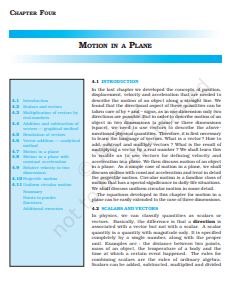‘NCERT Solutions for Class 11 Physics Chapter 4‘ PDF Quick download link is given at the bottom of this article. You can see the PDF demo, size of the PDF, page numbers, and direct download Free PDF of ‘Ncert Class 11 Physics Chapter 4 Exercise Solution’ using the download button.
NCERT Class 11 Physics Textbook Chapter 4 With Answer PDF Free Download

Chapter 5: Motion in a Plane
4.1 Introduction
In the last chapter, we developed the concepts of position, displacement, velocity, and acceleration that are needed to describe the motion of an object along a straight line.
We found that the directional aspect of these quantities can be taken care of by + and – signs, as in one dimension only two directions are possible.
But in order to describe the motion of an object in two dimensions (a plane) or three dimensions (space), we need to use vectors to describe the abovementioned physical quantities.
Therefore, it is first necessary to learn the language of vectors. What is a vector? How to
add, subtract and multiply vectors?
What is the result of multiplying a vector by a real number? We shall learn this to enable us to use vectors for defining velocity and acceleration in a plane.
We then discuss the motion of an object in a plane. As a simple case of motion in a plane, we shall discuss motion with constant acceleration and treat in detail the projectile motion.
Circular motion is a familiar class of motion that has a special significance in daily-life situations.
We shall discuss uniform circular motion in some detail. The equations developed in this chapter for motion in a plane can be easily extended to the case of three dimensions.
4.2 Scalars And Vectors
In physics, we can classify quantities as scalars or vectors. Basically, the difference is that a direction is associated with a vector but not with a scalar.
A scalar quantity is a quantity with magnitude only. It is specified completely by a single number, along with the proper unit.
Examples are the distance between two points, the mass of an object, the temperature of a body, and the time at which a certain event happened.
The rules for combining scalars are the rules of ordinary algebra. Scalars can be added, subtracted, multiplied, and divided.
4.2.1 Position and Displacement Vectors
To describe the position of an object moving in a plane, we need to choose a convenient point,
say O as the origin.
Let P and P′ be the positions of the object at time t and t′, respectively [Fig. 4.1(a)]. We join O and P by a straight line. Then, OP is the position vector of the object at time t. An arrow is marked at the head of this line. It is represented by a symbol r, i.e
| Author | NCERT |
| Language | English |
| No. of Pages | 24 |
| PDF Size | 636 KB |
| Category | Physics |
| Source/Credits | ncert.nic.in |
NCERT Solutions Class 11 Physics Chapter 4 Physical World
Q-1: State whether the following physical quantities are scalar or vector.
(i) Mass
(ii) Volume
(iii) Speed
(iv) Acceleration
(v) Density
(vi) Number of moles
(vii) Velocity
(viii) Angular frequency
(ix) Displacement
(x) Angular velocity
Ans:
Scalar: Density, mass, speed, volume, angular frequency, number of moles.
Vector: Velocity, acceleration, angular velocity, displacement.
A scalar quantity depends only on the magnitude and it is independent of the direction. Density, mass, speed, volume, angular frequency and number of moles are scalar quantities.
A vector quantity depends on the magnitude as well as the direction. Velocity, acceleration, angular velocity, displacement comes under this.
Q-2: From the following pick any two scalar quantities:
Force, angular momentum, work, current, linear momentum, electric field, average velocity, magnetic moment, relative velocity.
Ans:
The dot product of force and displacement is the work done. Work is a scalar quantity since dot product of two quantities is always scalar.
Current is a scalar quantity as it is described only by its magnitude and it is independent of direction.
Q-3: From the following identify the vector quantities:
Pressure, temperature, energy, time, gravitational potential, power, total path length, charge, coefficient of friction, impulse.
Ans:
Impulse is the product of force and time. Since force is a vector quantity, its product with time which is a scalar quantity gives a vector quantity.
Q-4: State with reasons, whether the following algebraic operations with scalar and vector physical quantities are meaningful :
(a) Addition of any two scalars
(b) Adding a scalar to a vector which has the same dimensions
(c) Multiplying a vector by any scalar
(d) Multiplying any two scalars
(e) Adding any two vectors
(f) Addition of a vector component to the same vector.
Ans:
(a) Meaningful:
The addition of two scalar quantities is meaningful only if they both represent the same physical quantity.
(b) Not Meaningful:
The addition of a vector quantity with a scalar quantity is not meaningful
(c) Meaningful:
A scalar can be multiplied with a vector. For example, force is multiplied with time to give impulse.
(d) Meaningful:
A scalar, irrespective of the physical quantity it represents, can be multiplied by another scalar having the same or different dimensions.
(e) Meaningful:
The addition of two vector quantities is meaningful only if they both represent the same physical quantity.
(f) Meaningful:
A component of a vector can be added to the same vector as they both have the same dimensions.
Motion in a Plane Textbook With Solutions PDF Free Download
